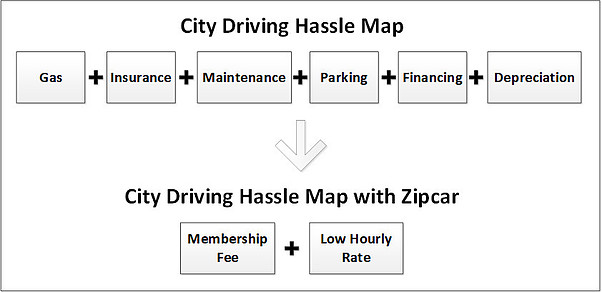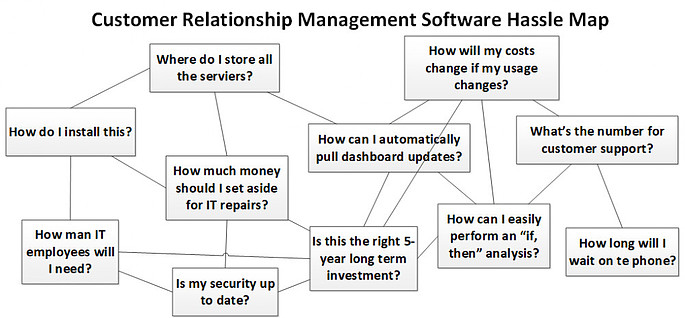Hassle Maps are a great strategic tool for managing and optimizing relationships customers and stakeholders. They have helped to transform businesses, especially when confronted with change, and have the potential to transform organizations and customer relationships of all types.
This post examines what Hassle Maps are, their usefulness, examples, and the application of Hassle Maps as a tool for strategy and project management.
What Is a Hassle Map?

The example above shows a Hassle Map for City Driving, transformed by a streamlined Hassle Map for City Driving with Zipcar. The streamlined Hassle Map is the basis for the disruptively innovative entry of Zipcar into the personal transportation market. A Hassle Map can be used to rework the organization’s value chain.
The concept of a Hassle Map was initiated by Adrian Slywotsky as an extension of his work on Value Migration. Businesses can protect their strategic positions in large part by maintaining close touch with their customers. Slywotsky defined a Hassle Map as:
“…a hassle map defines all the actual steps that characterize the negative experiences of the customer… Where are the emotional hot spots, the irritations, the frustrations, the time wasted, the delay? Where are the economic hot spots? … What are the ways that businesses can radically improve the hassle map for both the customer and themselves?”
In particular, businesses – as well as non-commercial organizations that serve customers – can map out the ‘hassle factors’ that their customers experience. These hassle factors are not static, and evolve over time, with evolution of needs and technology.
A mapping of these hassle factors – a Hassle Map – can help identify evolving areas where the company needs to improve its process of supporting the customer.
A Hassle Map documents visually the customer experience steps that cause angst and irritation – and potentially can be a cause for a customer to go elsewhere. It can help protect an organization by helping it to maintain and enhance its relevance to customers
Hassle Maps are created to identify the negatives in the customer’s experience. It is useful to start out that process with questions such as:
- What do you hate about this?
- What makes you furious?
That’s a good start for getting everyone into the right frame of mind.
Where Is a Hassle Map Useful?
 Hassle Maps have numerous broadly defined uses, including:
Hassle Maps have numerous broadly defined uses, including:
- Looking at different customer groups – The customer experience is different for each type of customer. That means each type will have a different Hassle Map. This might require building a Hassle Map at least for major customer or stakeholder groups.
- Looking outside the industry – A Hassle Map provides a reference point for inserting best practices. It is helpful to look outside your industry for different ways that others have found to connect the dots.
- Quantify economics for the consumer – A Hassle Map can enable you to identify all costs – tangible and intangible – of the product or service. It reveals a better understanding of the total cost to the customer.
- Quantify economics for the organization – A Hassle Map can also reveal the real cost to the organization! It may include many hidden costs that are uniquely revealed by the Hassle Map.
- Identify steps for optimizing – Once you see what you have, you can pinpoint areas for improvement. You can try to optimize for both the consumer/stakeholder and the organization.
The end result of using Hassle Maps is to better serve customers and protect the business strategically. That includes maximizing profit, and choosing the customers the organization will serve (and those it will not). Finally, a Hassle Map can be part of the process to monitor and adjust as required moving forward.
Hassle Maps can be useful in business, but also in any organization. Here are just a few examples:
- Government organizations – How can we be easier for citizens to work with?
- New ventures – Can we come up with a better way to serve customers than incumbents?
- Established companies – How can we better serve customers to defend our market positions?
- Non-profits – How can we make it easier to donate, deliver services, and consume our services?
- Countries, states, provinces, cities – How can we present a more hassle-free value proposition?
Hassle Maps are very useful across a wide range of applications.
How Do I Build a Hassle Map?
Another example can illustrate this well.
This map shows connections among Hassles, as opposed to a sequence of tasks. It maps the range of Hassles a customer must endure in order to use CRM software. Similar maps could be made of just about any out-of-the-box software, as this was a precursor to hosted, on-demand software.
Now let’s look at how salesforce.com transformed this set of Hassles and created the Software as a Service (SaaS) model.
Here are three very simple steps to frame the process of building a Hassle Map:
- Map the existing process – Start with a detailed baseline. This surely takes work and validation with key stakeholders.
- Identify steps to remove – Look for breaks or discontinuities in the process. Look for duplication, or unnecessary actions or steps.
- Map the new steps – Brainstorm and look for easier ways. Involve customers if possible.
Hassle Maps and Strategy
 The Hassle Map is a tool that can be used to map out key negative aspects of the customer experience. Hassle Maps can help navigate through changing circumstances to help maintain close customer relationships and to ensure that the organization is providing what customers need.
The Hassle Map is a tool that can be used to map out key negative aspects of the customer experience. Hassle Maps can help navigate through changing circumstances to help maintain close customer relationships and to ensure that the organization is providing what customers need.
The Hassle Map examples of Zipcar and Salesforce.com above show how Hassle Maps can drive highly innovative and transformational strategies.
—————————————-
I recommend these strategy resources (paid link):
—————————————-
The value chain is the sum of all activities that prov
A big consideration at the strategic level is the portfolio of businesses. It can be helpful to think in terms of portfolios of customer types. Each of these types has transformational possibilities that can be revealed by Hassle Maps.
With sets of Hassle Maps in hand for each business and each type of customer, strategists can work to optimize the portfolio for both customer and organization.
Hassle Maps in Project Management
Do Hassle Maps have a place in a Project Manager’s tool kit?
Absolutely!
Here are a few ways to put Hassle Maps to use related to projects:
- Hassle Maps for Stakeholders – For Project and Program Managers, different groups have different needs and experiences. Projects have customers! Usually the customers can be segmented into useful interest groups, such as users, area managers, executives, product managers, etc. Each of these groups can potentially be represented by a Hassle Map, which can be simplified to create happier customers and stakeholders.
- PMO Creating Hassle Maps of Its Stakeholders – PMO’s have the overall business units as stakeholders. What are the Hassles that certain groups of stakeholders experience? What can be done to make their lives easier? This can help force the PMO to create value and maintain relevance as a customer centric corporate citizen.
- Hassle Maps of Business Processes – Employees are customers, or at least stakeholders, of the business. Business processes can often be frustrating. Taking a Hassle Map approach to streamlining business processes can facilitate positive change within the organization, create efficiencies that save money, and make employees happier and more productive.
There are many ways that Project Managers can employ the use of Hassle Maps as a useful tool in the tool kit.
Conclusion and Further Resources
To gain more insights on Hassle Maps, I suggest the following articles:.
“Hassle Maps: Improving performance by bringing the customer experience to life“, by Liz Carter of Loft9 Consulting.
“Adrian Slywotzky Interview: What Is a Hassle Map?“, by Curt Finch, Inc Magazine.
—————————————-
I recommend these PM templates (paid link):
—————————————-




